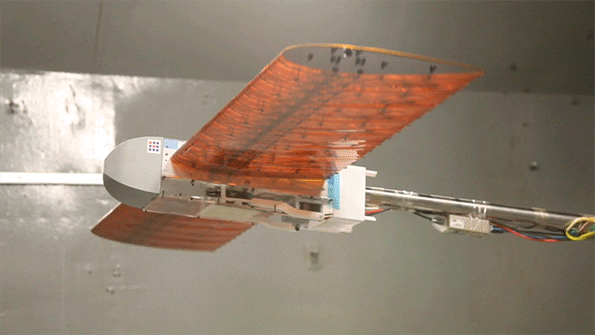Morphing Wings Are 1st Step Toward Bird-Like Aircraft

Bendable, morphing wings covered with overlapping pieces resembling scales or feathers could be used to build more agile, fuel-efficient aircraft, a new study finds.
Nowadays, conventional aircraft typically rely on hinged flaps known as ailerons to help control the way the planes tilt as they fly. However, when the Wright brothers flew the first airplane, Flyer 1, more than a century ago, they did not use ailerons. Instead, they controlled the aircraft using wires and pulleys that bent and twisted the wood-and-canvas wings.
Scientists have long sought to develop aircraft that can alter or morph their wings during flight, just as birds can. In theory, morphing wings would create smoother aerodynamic surfaces, making an aircraft more agile and efficient than an aircraft that flies with many separate moving surfaces. [Up She Goes! 8 of the Wackiest Early Flying Machines]
However, most previous attempts to develop morphing wings have failed because they relied on mechanical control structures within the wings that were so heavy they canceled out any advantages that morphing provided. These structures were also complex and unreliable, said study co-author Neil Gershenfeld, a physicist and director of the Center for Bits and Atoms at MIT.
"People have worked on morphing aerodynamics for years, but progress has been slow," Gershenfeld told Live Science.
But these new morphing wings allowed the researchers to "make the whole wing the mechanism," Gershenfeld said in a statement. "It's not something we put into the wing."

The new wing architecture consists of a system of tiny, strong, lightweight modules. The shape of the wing can be changed uniformly along its length using two small motors, which apply a twisting pressure to each wingtip.
Sign up for the Live Science daily newsletter now
Get the world’s most fascinating discoveries delivered straight to your inbox.
These wings are covered in "skins" of overlapping strips of flexible material resembling fish scales or bird feathers. These strips move across each other as the wings morph, providing a smooth outer surface, the researchers explained.
Wind-tunnel tests of these wings showed that they at least matched the aerodynamic properties of conventional wings, at about one-tenth the weight. Initial tests using remotely piloted aircraft made with these wings have shown great promise, said study lead author Benjamin Jenett, a graduate student at the Center for Bits and Atoms at MIT. "The first tests were done by a certified test pilot, and he found it so responsive that he decided to do some aerobatics," Jenett said in a statement.
Even small improvements in fuel efficiency can have significant impacts on the economics of the airline industry and its contribution to greenhouse gas emissions.
"The goal is to build the whole aircraft this way, both manned and unmanned, so you can deform their shapes," Gershenfeld said. "The wings are just the first step."
The researchers noted that building large structures such as airplane wings from an array of small, identical building blocks — what Gershenfeld called "digital materials" — greatly simplifies the manufacturing process. Whereas the construction of light composite wings for aircraft currently requires large, specialized equipment for layering and hardening the material, the new modular structures the scientists developed could be manufactured quickly in mass quantities and then assembled by teams of small robots.
"We mass-produce pieces and assemble them like they're Legos," Gershenfeld said.
These modular structures also can be disassembled more easily, making repairs simpler. "An inspection robot could just find where the broken part is and replace it, and keep the aircraft 100 percent healthy at all times," Jenett said in a statement.
Still, the first aircraft built using this strategy will not be a passenger jet, Gershenfeld said. Instead, the technology will likely first be tested on unmanned aircraft, leading to drones that can fly for long times, to help deliver internet access or medicine to remote villages, he said.
The scientists detailed their findings online Oct. 26 in the journal Soft Robotics.
Original article on Live Science.











